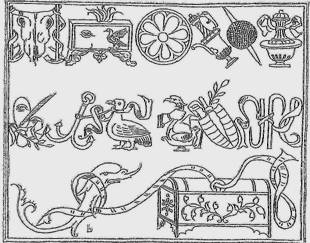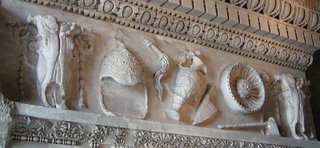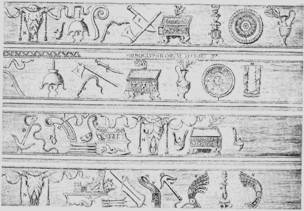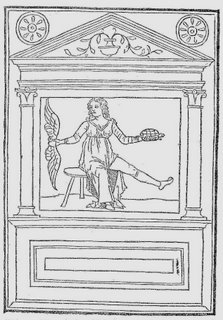My favorite book of 2008
was L'idee de fable by Teresa Chevrolet subtitled Theories de la fiction poetique a la Renaissance (Droz, 2007) a 700 page tome covering many aspects of the symbolic literature of the period. Not only is the material fascinating but it is written in a discursive style which I particularly liked, if only as an example of good writing. Chevrolet uses every grammatical, syntactical and oratorical trick to express difficult concepts clearly and in this blog, I will try and summarize some of the subject matter to give an indication of its wide scope.
As Chevrolet says the main purpose of the book is to study the relationship of the fable or allegory to truth but this general theme includes many topics: the relationship of poets and philosophers, mystery and secrecy, the tension between the wish to conceal secret knowledge from the uninitiated and the simultaneous didactic desire to reveal those same secrets, the impact of the discovery of the hieroglyphs, negative theology, silence as a limit for figuration, the distinction between words and things and between the sweet and useful, the evolution of allegory into the exemplum, poetry as a form of logic and its relationship to ethics, the development of fantasy and imagination out of mimesis, the necessity for decorum, the concept of enargeia and verisimilitude, the persistence of Aristotle's goal for poetry of the marvellous, which in turns leads on to the sublime, and finally the development of conceptisme or wit. Along with this dizzying list, mouthwatering for any student of the subject, is an examination of almost all the theoretical treatises of the age on poetics. I confess to having got bogged down in some of the latter and in, for instance, the details of the debate between Castelveltro and Patrizi on the relative merits of Plato's and Aristotle's approaches to mimesis. but this was a small price to pay for a cornucopia of information and discussion.
Chevrolet starts with the strictures of Plato on the status of the poet. According to Plato, as we know, the poet was doubly a liar since first he distorted the things of nature and these in turn were only reflections of Plato's absolute Ideas. This was a bad start for poetry and much of the discussion on poetics for the next two thousand years, was how to reconcile this implication of mendacity with creativity and imagination. One solution was to rationalize the use of allegory; it was acceptable, if the literal text was intended to point to a concealed moral injunction. Another was that of Aristotle who indicated that mimesis, the function of poetry, could depict nature as it should be, as a product of the imagination, as well as nature as it actually was. St Augustine further validated the genre in his Contra Mendacium where he distinguished between fiction and lying.
The rediscovery, late in the Renaissance, of Aristotle's Poetics reignited the debates about the nature of poetry and gave rise to a proliferation of treatises on the subject. The Poetics gave scope for a more imaginative view of the poet's task, of seeing mimesis as descriptive of action and of allowing fantasy in addition to allegory, as descriptive of things as they should be rather than just as they were. Henceforth art was to 'transfigure' nature.
In spite of its length and depth, this book deserves to be read again and again and I hope I can find the time to do just that.

 The frieze from the Temple of Vespasian
The frieze from the Temple of Vespasian The Capitoline Frieze
The Capitoline Frieze A fresco from San Giustina
A fresco from San Giustina From the Poliphili
From the Poliphili Fantastic letters from the Champ Fleury
Fantastic letters from the Champ Fleury